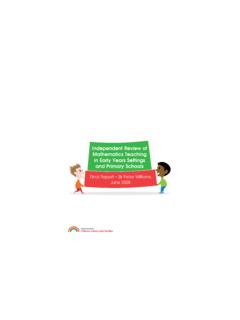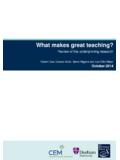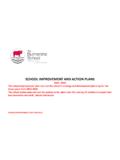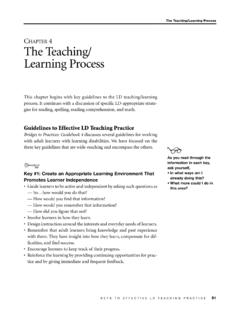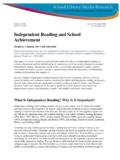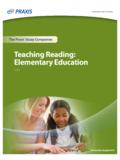Transcription of Independent review of the teaching of
1 Independentreview of theteaching of early readingFinal Report, Jim Rose, March 2006 ContentsLetter to the Secretary of StateParagraph1. Summary2. The remit for the review 1 3. Evidence gathering54. Background6 1: what best practice should be expected 30in the teaching of early reading and synthetic 2: how this relates to the development 89of the birth to five framework and the development and renewal of the National Literacy Strategy Framework for 3: what range of provision best supports131children with significant literacy difficulties and enables them to catch up with their peers, and the relationship of such targeted intervention programmes with synthetic phonics 4.
2 How leadership and management in schools 163can support the teaching of reading, as well as practitioners subject knowledge and 5: the value for money or cost effectiveness of173the range of approaches the review considers10. Evidence from practice20411. Recommendations240 Appendix 1: The searchlights model: the case for changeAppendix 2: Glossary of termsAppendix 3: Sources of evidenceDear Secretary of State,This is the final report of the Reading review ,which you invited me to undertake in June2005. It builds on the interim report that waspublished on 1st December fulfilling its remit, the review has drawnupon three main sources of information: thefindings of research and inspection; wide-ranging consultation, includingpractitioners, teachers, trainers, resourceproviders and policy makers, and visits tosettings, schools and training is no surprise to find that the mainingredients for success in the teaching ofbeginner readers are: a well trained teachingforce; well designed, systematic programmesof work that are implemented thoroughly.
3 Incisive assessment of teaching andlearning, and strong, supportive best, our settings and schools draw uponthese factors and embody the principles ofhigh quality phonic work within a language-rich curriculum that gives rise to highstandards of reading and writing. It followsthat the challenge now is to ensure that, inall settings and schools, the teaching andlearning of early reading and writing ingeneral, and phonic work in particular,measure up to this best with the interim report, this reportmarshals findings and comments under theaspects set out in the remit for the the nature of the task, it is hardlysurprising that genuinely held viewsdiffered, sometimes widely, about aspects ofthe remit.
4 However, all respondents unitedaround the aim of securing reading as anentitlement for every child. I hope that thefindings and outcomes of the review willinform the means to that wish to thank the many respondents,including those who have contributed sohelpfully to visits by the review . I am alsograteful to the advisory group and Ofsted fortheir valuable contributions and to mysupport team whose application and hardwork throughout the exercise have beenquite sincerelyJim Rose CBE2 EDUCATION AND SKILLSINDEPENDENT review OF THE teaching OF EARLY READING: FINAL REPORTOver the first nine years of the NationalCurriculum (1989 to 1998) very little impactwas made on raising standards of the content of phonic work being astatutory component of the NationalCurriculum over that time, reports from HerMajesty s Inspectors show that it was often aneglected or a weak feature of the changed markedly with the advent ofthe National Literacy Strategy in 1998.
5 TheStrategy engaged schools in developing astructured teaching programme of literacythat included not only what phonic contentshould be taught but also how to teach it,with a subsequent rise in forthcoming Early Years FoundationStage and the renewal of the PrimaryNational Strategy framework for teachingliteracy provide powerful opportunities toreinvigorate and build upon theseachievements and greatly reduce arbitraryboundaries between the Foundation Stageand Key Stage 1, without compromising thehard won, distinctive merits of the areas oflearning and experience in the early so doing, the new Early Years FoundationStage and the renewed framework shouldmake sure that best practice for beginnerreaders provides them with a rich curriculumthat fosters all four interdependent strandsof language: speaking, listening, reading andwriting.
6 The indications are that far moreattention needs to be given, right from thestart, to promoting speaking and listeningskills to make sure that children build a goodstock of words, learn to listen attentively andspeak clearly and confidently. Speaking andlistening, together with reading and writing,are prime communication skills that arecentral to children's intellectual, social andemotional development. All these skills aredrawn upon and promoted by high quality,systematic phonic young children in interesting andworthwhile pre-reading activities paves theway for the great majority to make a goodstart on systematic phonic work by the ageof five.
7 Indeed, for some, an earlier start maybe possible and desirable. This is because itill serves children to hold them back fromstarting systematic phonic work that ismatched to their developing abilities andenables them to benefit from the wealth ofopportunities afforded by reading from anearly age. All that said, the introduction ofphonic work should always be a matter forprincipled, professional judgement based onstructured observations and assessments ofchildren s term formal in the pejorative sense inwhich phonic work is sometimes perceivedin early education is by no means a fairreflection of the active, multi-sensorypractice seen and advocated by the reviewfor starting young children on the road AND SKILLSINDEPENDENT review OF THE teaching OF EARLY READING.
8 FINAL REPORT3 SummaryDespite uncertainties in research findings,the practice seen by the review shows thatthe systematic approach, which is generallyunderstood as 'synthetic' phonics, offers thevast majority of young children the best andmost direct route to becoming skilledreaders and writers. When thinking aboutphonic work, what most people have inmind is the teaching and learning ofreading. However, phonic work is alsoessential for the development of writing,especially spelling. The teaching ofbeginners must lead them to understandhow reading and writing are is widely agreed that reading involves farmore than decoding words on the , words must be decoded ifreaders are to make sense of the text.
9 Phonicwork is therefore a necessary but not sufficientpart of the wider knowledge, skills andunderstanding which children need tobecome skilled readers and writers, capable ofcomprehending and composing text. Forbeginner readers, learning the core principlesof phonic work in discrete daily sessionsreduces the risk, attendant with the so-called searchlights' model, of paying too littleattention to securing word recognition consequence, the review suggests areconstruction of the searchlights model for differences in presentationand aspects of content, well designedprogrammes, including those fromcommercial sectors, for teaching andlearning phonics systematically, tend toconverge around a small number of coreprinciples.
10 It is implementing the principleswhich define high quality phonic work thatshould engage settings and schools, ratherthan debating entrenched views about lessimportant aspects of phonics , developing children s positiveattitudes to literacy, in the broadest sense,from the earliest stage is very important. Inthe best circumstances, parents and carers,along with settings and schools, do much tofoster these attitudes. For example, theystimulate children s early interest in literacyby exploiting play, story, songs and rhymesand provide lots of opportunities, and time,to talk with children about their experiencesand feelings.










